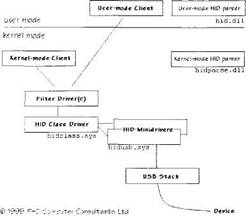Книга: Writing Windows WDM Device Drivers
HID Hides
HID Hides
This chapter describes the Human Input Device (HID) model, a standard way of interacting with user input devices. A HID device uses various descriptors to define its capabilities. A Report descriptor details the input reports that it can generate and the output reports it can receive. The next chapter describes how to write Windows client device drivers and user mode applications that can talk to HID devices.
The HID specification is an abstract model for most types of input device that people will use to control their computers. An input device can be a plain old keyboard, for example, a vehicle simulation rudder, or the soft on/off button for the computer.
The HID specification was written originally for USB devices and closely follows the USB descriptor model. However, it is sufficiently generic for HID to be used with other types of device.
Naturally, most of the time a HID device provides input data to the computer. However, you can output to a HID device (e.g., to turn on the NumLock LED on a keyboard). You can also control a feature of the device, such as the font used on a display device or an LED color.
In Windows, the system HID class driver provides an abstract view of the input device. The HID device itself can be a USB device, a IEEE 1394 device or even a plain PC-compatible device, provided an appropriate HID minidriver is written to interface to the bus or device.
In this chapter and the next, quite a few of the examples are about getting input from a keyboard. It does not matter whether you are using a USB keyboard or a (hypothetical) IEEE 1394 keyboard. The system still gets keystrokes in exactly the same way, from the HID class driver. As the next chapter shows, Windows does get input from an old PC-compatible keyboard by a different route. Perhaps eventually a minidriver will be written so that HID will provide all the keyboard input.
HID in Windows
Figure 22.1 shows how HID devices are used in Windows. A user mode or kernel mode HID client program calls the HID device stack. The stack always contains the system HID class driver, Hidсlass.sys, optionally with HID filter drivers above it. The HID class driver uses HID minidrivers to interface to hardware. In the figure, one of the minidrivers, HidUsb.sys. uses the USB stack to talk to a device.
Figure 22.1 HID drivers and clients

HID provides an abstract model of input devices, so client programs are not concerned with the details of where input comes from. HID models a device as various controls representing the device. A keyboard, therefore, usually has single-bit control representing the state of each modifier key, such as the left Shift key, and it has an array of scan code byte controls representing the other keys that are currently pressed.
Underlying the HID model are compact, but complicated, structures for passing information. HID device engineers and minidriver writers will need to know these structures. However, clients can just use various Windows parsing routines to access the relevant data. There are parsers for HID reports available to both kernel mode, Hidparse.dll, and user mode clients, Hid.dll.
The system HID class driver does most of the hard work. It delegates its hardware interactions to HID minidrivers. Windows includes a HID minidriver HidUsb.sys for the devices on the USB bus, but new minidrivers can be written, if necessary. New USB devices that have the appropriate HID Interface class constants and HID descriptors will not need a new minidriver. The system USB HID minidriver calls the system USB driver USBD.sys, optionally through any lower-level USB filter drivers. The system USB driver then talks to the device, etc.
A HID client, therefore, just talks to the HID class driver. The Windows operating system itself is an example of a kernel client, as it can get its keyboard and mouse input via HID. You can write kernel mode client drivers to use a HID device. However, it is often easier to write a Win32 program that talks directly to the HID class driver.
- 8.4.4 HID Descriptors
- Using the HID Terminal of mikroC
- Hiding Your NetWare Login Password
- Chapter 23 HID Clients
- 2.7.1 Hiding the Toolbar
- Скрытие информации (information hiding)
- The HID Model
- 7.4.3 Editing While Text Is Hidden
- Location Providers: They Know Where You’re Hiding
- HID Model Representation
- HID Class Driver
- User Mode HID Clients




